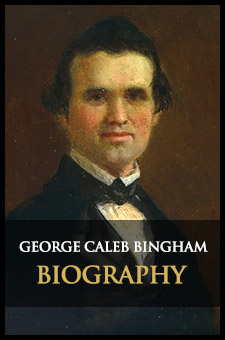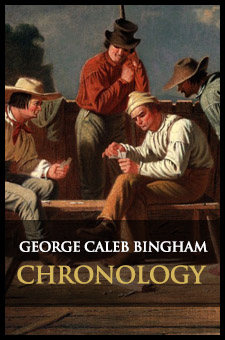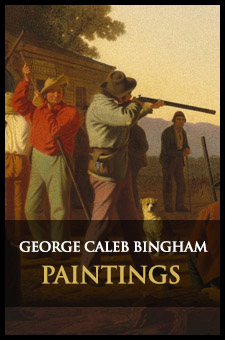Order No. 11
Prelude
By 1863, in the middle of the Civil War, violence on the Missouri-Kansas border had become so extreme that no one was safe regardless of loyalty. Military engagements were fought not on the battlefield, but in woods, along roadways, in farm fields, and in town squares. Most fights were skirmishes between small numbers of bushwhackers and rebels against state militias and federal troops. Much of the bushwhackers’ success came from support they received from farmers with southern sympathies.[1]
Order No. 11
After August 21, 1863, when William Quantrill’s Raid on Lawrence, Kansas, left some 200 men and boys dead, Federal authorities had to take drastic measures. On August 23, the Commander of the District Border, Brigadier-General Thomas Ewing, Jr. — William Tecumseh Sherman’s foster brother — issued Order No. 11. The military war measure ordered everyone, including women, children, and elderly, to evacuate four Missouri border counties: Bates, Cass, Jackson, and Vernon. People were permitted to stay only if they could establish Union loyalty, a nearly impossible task in an area so divided. The refugees could take their personal belongings, but troops were to seize all grain and hay and destroy all crops.
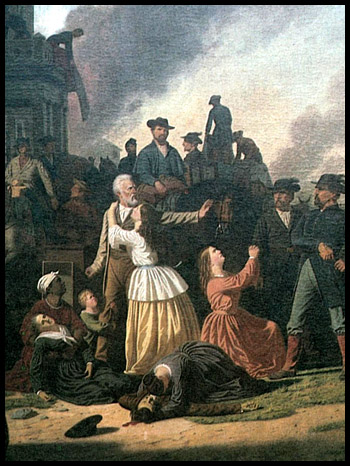
George Caleb Bingham
Martial Law or Order No. 11 (2) 1869 (Detail)
State Historical Society of Missouri
Columbia, Missouri
Artist George Caleb Bingham, a staunch supporter of the Union and who was serving as the Missouri State Treasurer, knew that many of those who would be displaced were neutral, law-abiding citizens who wanted the radical elements on both sides to leave them alone to live their lives. He protested to Ewing, but without effect.
Yet the effects of the dispersal were even worse than Bingham feared.
On September 9th six men ranging between the ages of 75 to 17 were killed by members of the Kansas 9th Regiment. There were some 40,000 residents living within the four affected counties when Order No. 11 was issued. Within 15 days, the population of Cass County decreased from about 7,000 to around 800. Bates and northern Vernon counties became ghost counties. The total population of Jackson County evicted under Order No. 11 is estimated at about 14,000 citizens.[2]
The Painting
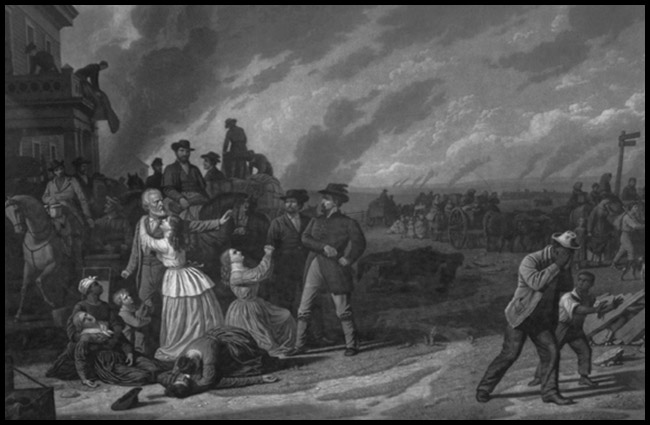
John Sartain (1808-1897) after George Caleb Bingham
Line and mezzotint engraving
Private Collection
Bingham had promoted and defended the federal government for years. That a representative of that government could mandate such destruction, that scoundrels in federal uniforms could reek such devastation on non-combatants, changed him forever. He poured his outrage at these excesses onto a carefully composed canvas to commemorate the event. Moreover, he intended the painting to serve as a warning to future generations of abuse of federal power.
Despite his patriotic good intentions, war wounds were still too raw. Vocal unionists accused him of supporting treason through his painting. In truth, Bingham was one of the last people who should be considered a traitor.
Healing
Over 150 years later, as confederate monuments are being removed, former New Orleans Mayor Mitch Landrieu gave a pragmatist’s view of the situation in an interview in Hyperallergic. Landrieu said, “This is not much different from things that happen in our personal lives. When you do something that offends somebody else, before you move forward, you have to acknowledge the wrong, say, “I’m sorry,” and then the receiving party has to say, “I forgive you.”
If the federal government were to say, “I’m sorry,” to the descendants of the non-combatants displaced by Order No. 11, would the receiving party say, “I forgive you”? Would the war wounds finally heal?
Footnotes:
1. Adapted from Ralph Monaco, II Scattered to the Four Winds: General Order No. 11 and Martial Law in Jackson County, Missouri, 1863 (Monaco Publishing, 2010).
2. Ralph Monaco, II , Scattered to the Four Winds: General Order No. 11 and Martial Law in Jackson County, Missouri, 1863, op. cit.

